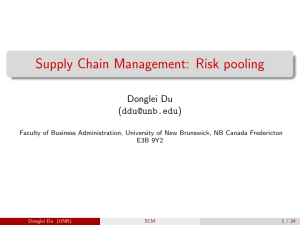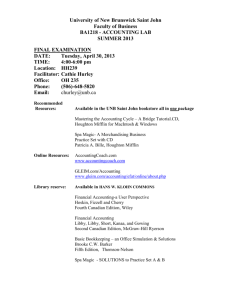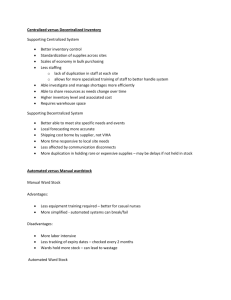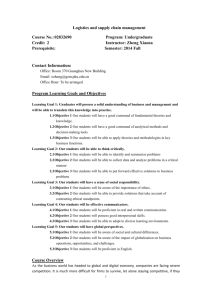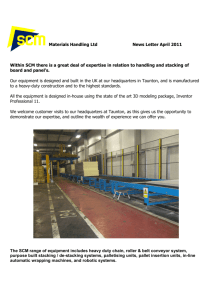Supply Chain Management: Risk pooling
advertisement
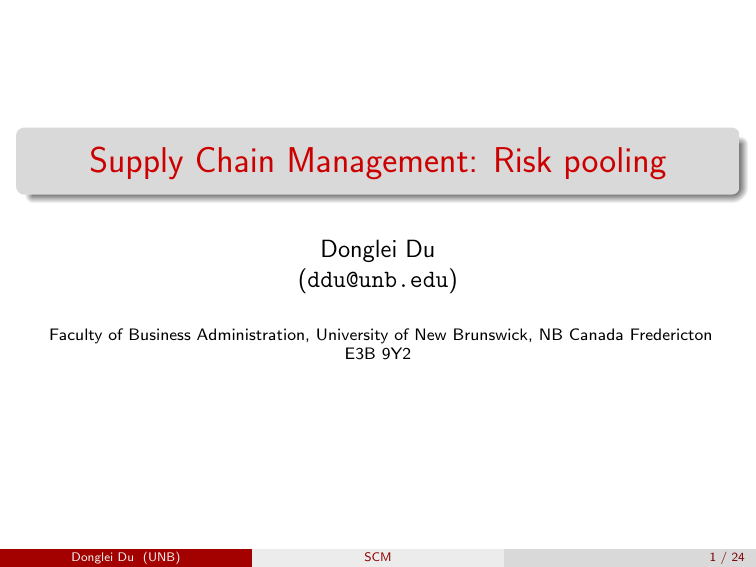
Supply Chain Management: Risk pooling Donglei Du (ddu@unb.edu) Faculty of Business Administration, University of New Brunswick, NB Canada Fredericton E3B 9Y2 Donglei Du (UNB) SCM 1 / 24 Table of contents I 1 Introduction 2 The theory behind risk pooling 3 A case study 4 Observations from the case 5 Benefits of Risk Pooling 6 Centralized vs decentralized systems Donglei Du (UNB) SCM 2 / 24 Section 1 Introduction Donglei Du (UNB) SCM 3 / 24 Risk Pooling I Risk Pooling involves using centralized inventory instead of decentralized inventory to take advantage of the fact that if demand is higher than average at some retailers, it is likely to be lower than average at others. This reduction in variability directly leads to a decrease of the safety stock, √ ST = zα Lσ, (1) and eventually leads to reduction in average inventory √ Lµ + ST = Lµ + zα Lσ. Donglei Du (UNB) SCM 4 / 24 Risk Pooling II Thus, if each retailer maintains separate inventory and safety stock, a higher level of inventory has to be maintained than if the inventory and safety stock are pooled. Therefore the system with risk pooling has less overall inventory and is thus cheaper to operate with the same service level. Donglei Du (UNB) SCM 5 / 24 Section 2 The theory behind risk pooling Donglei Du (UNB) SCM 6 / 24 Risk Pooling Var(X1 + X2 ) = Var(X1 ) + Var(X1 ) + 2Cov(X1 , X2 ) ≤ σ 2 (X1 ) + σ 2 (X2 ) + 2σ(X1 )σ(X2 ) ≤ (σ(X1 ) + σ(X2 ))2 ⇓ σ(X1 + X2 ) ≤ σ(X1 ) + σ(X2 ) The first inequlity above follows from the Cauchy-Schwarz inequality: |Cov(X1 , X2 )| ≤ σ(X1 )σ(X2 ) Donglei Du (UNB) SCM 7 / 24 Section 3 A case study Donglei Du (UNB) SCM 8 / 24 A case study Let us consider the case. Decentralized System 1.05Q Warehouse One Market One Warehouse Two Market Two Supplier Lead time =1 Centralized System SL=0.97, S=60,H=0.27 Market One Supplier 1.10Q Warehouse 0.97 service level Donglei Du (UNB) SCM Market Two 9 / 24 Characteristic of centralized and decentralized systems I two products with historical data given in the following table: Week 1 2 3 4 5 6 7 8 Prod A, Market 1 Prod A, Market 2 Prod B, Market 1 Product B, Market 2 33 45 37 38 55 30 18 58 46 35 41 40 26 48 18 55 0 2 3 0 0 1 3 0 2 4 0 0 3 1 0 0 maintain 97% service level $60 order cost $.27 weekly holding cost Donglei Du (UNB) SCM 10 / 24 Characteristic of centralized and decentralized systems II $1.05 transportation cost per unit in decentralized system, $1.10 in centralized system 1 week lead time Note that the demand for Product B is fairly small relative to the demand for product A. Donglei Du (UNB) SCM 11 / 24 Analysis of the two systems I The following table gives a summary of the average and standard deviation of demands for each product in both the decentralized and centralized systems. Warehouse Product AVG STD CV s S Market 1 A 39.3 13.2 .34 65 197 Avg. % Inven. Dec. 91 Market 2 A 38.6 12.0 .31 62 193 88 Market 1 B 1.125 1.36 1.21 4 29 14 Market 2 B 1.25 29 15 Cent. Cent A B 77.9 20.7 .27 2.375 1.9 .81 1.58 1.26 5 118 304 6 39 132 20 36% 43% We explain how to get the information in the last four columns Donglei Du (UNB) SCM 12 / 24 Analysis of the two systems II 1 Column with ”s”: s is the reorder point q 2 + µ2 σ 2 s = ROP = µD µL + zα µL σD D L For example the ROP for product A at market 1 is given by (note that z0.03 = 1.89 q 2 + µ2 σ 2 s = ROP = µD µL + zα µL σD D L p = 39.3(1) + z0.03 1(13.2)2 + (39.3)2 (0) = 39.3 + 1.89(13.2) ≈ 65 Donglei Du (UNB) SCM 13 / 24 Analysis of the two systems III 2 Column with ”S”: S is the order-up-to point. Suppose we use the EOQ order quantity, then r 2Ds ∗ S =s+Q=s+Q =s+ h For example, the S for product A at market 1 is given by r 2Ds S =s+S = s+ h r 2(39.3)(60) = s+ 0.27 ≈ 65 + 132 = 197 Donglei Du (UNB) SCM 14 / 24 Analysis of the two systems IV 3 Column with ”Average Inventory”: Average Inventory = Safety Stock+ Q = zα 2 q 2 + µ2 σ 2 + µL σ D D L Q 2 For example, the Average Inventory for product A at market 1 is given by q 2 + µ2 σ 2 + Q µL σ D D L 2 132 = 1.89(13.2) + ≈ 91 2 Average Inventory = zα Donglei Du (UNB) SCM 15 / 24 Analysis of the two systems V 4 Column with decreasing percent: This tells the change of average inventory between the decentralized and centralized systems, given by decentralized average inventories - centralized average inventories centralized average inventories For example, the average inventory for Product A is reduced by (91 + 88) − 132 ≈ 36% 132 when we shift from the decentralized system to the centralized one. Donglei Du (UNB) SCM 16 / 24 Section 4 Observations from the case Donglei Du (UNB) SCM 17 / 24 Observations from the case Note that the average demand faced by the centralized warehouse is the sum of the average demand faced by each of the two warehouses in the decentralized system. However, the variability faced by the centralized warehouse, measured either by the standard deviation or coefficient of variation, is much smaller than the combined variabilities faced by the two warehoused in the decentralized system. Donglei Du (UNB) SCM 18 / 24 Section 5 Benefits of Risk Pooling Donglei Du (UNB) SCM 19 / 24 General Observations on Risk Pooling I Centralizing inventory control reduces both safety stock and average inventory level for the same service level. Intuitively, in a centralized distribution system, whenever demand from one market area is higher than average while demand in another market area is lower than average,items in the warehouses that are originally allocated for one market can be reallocated to the other. This reallocation process is not possible in a decentralized system where different warehouses serve different markets. The benefit of risk-pooling depends on the standard deviation (SD) or the coefficient of variation (CV) among the different markets. The higher the SD/CV, the greater that potential benefit from centralized system becase of equation (1). Donglei Du (UNB) SCM 20 / 24 General Observations on Risk Pooling II The benefit of risk-pooling also depends on the demand correlation among the different markets. Var(X1 + X2 ) = Var(X1 ) + Var(X1 ) + 2Cov(X1 , X2 ) We say the demands are positively correlated if the demands in both markers are increasing or decreasing in the same direction; that is, Cov(X1 , X2 ) ≥ 0. The benefit decreases as the correlation between demand from two markets becomes more positive, as the standard deviation becomes larger. There are many Types of Risk Pooling, here are some examples Risk Pooling Across Markets Risk Pooling Across Products Risk Pooling Across Time Donglei Du (UNB) SCM 21 / 24 Section 6 Centralized vs decentralized systems Donglei Du (UNB) SCM 22 / 24 Centralized vs decentralized systems I What are the tradeoff that we need to consider in comparing centralized vs decentralized systems? When we switch from a decentralized system to a centralized system: Safety stock usually decreases, leading to decrease in average inventory level and hence reduction in inventory holding cost. The magnitude of the increase depends on the SD and/or CV and the correlation between the demand from the different markets. Service level increases and the magnitude of the increase depends on the SD/CV and the correlation between the demand from the different markets. Overhead costs decreases as there are more economies of scale. Customer lead time becomes longer. Donglei Du (UNB) SCM 23 / 24 Centralized vs decentralized systems II Transportation costs increases on the outbounds and decreases on the inbounds. The net impact on total transportation cost is not immediately clear. Donglei Du (UNB) SCM 24 / 24

